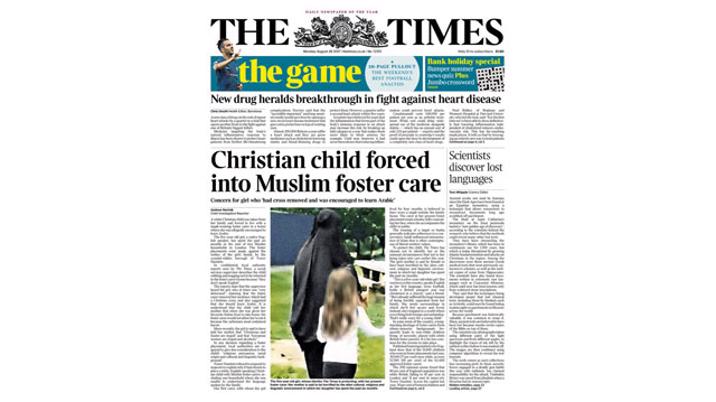
How many first offenders are sent straight to jail after inflicting minor knife wounds on a friend?
How many Muslim, African, east European children are fostered with white Christian families?
This isn’t a game of Trivial Pursuit, but the reality of Serious Questions. Or rather the lack of them.
Take three big stories of recent months:
- Lavinia Woodward, the Oxford medical student who “stabbed” a boyfriend but was “too clever” to go to jail;
- the white Christian girl “forced into Muslim foster care” by Tower Hamlets council;
- and Charlie Gard, the baby whose doctors not only refused him a crack at a non-existent treatment, but also denied his parents their final wish that he die at home in a cot he’d never slept in.
In each instance, the invitation for readers to be affronted was implicit. And in each instance, key questions were not answered (or even asked?). The result was that readers were denied the full picture and may well have reached the wrong conclusions.
Embattled newspapers rail at the social media giants, complaining that they don’t have to abide by the codes that regulate the press, that they don’t invest in journalism, that they can publish dangerous and inaccurate information with gay abandon – and that they are stealing readers and putting “proper” journalism at risk.
All of that is largely true.
But it is also the case that newspapers are spending less on their journalism and that some have a careless attitude to their own code of practice. If they want to be seen as reliable voices, as the tellers of truth, is it not incumbent upon them to examine all aspects of a story and put events into context, rather than make simplistic assumptions and expect readers to draw the prescribed conclusions?
Miscarriage of justice?
Take Lavinia Woodward. Press and broadcasters alike used the verb “stabbed” to describe how she attacked a boyfriend with a bread knife. A bread knife has a curved end; it is not possible to stab someone with a bread knife. The judge did not use the word “stab”. He did, however, describe the injuries she inflicted: a 3cm cut on the leg that required three stitches, and two tiny nicks on his fingers.
Nor did he say that she was “too clever” to go to jail. What he did was follow sentencing guidelines for the offence to which she pleaded guilty and explain why he didn’t think it a good idea to send her to prison.
The mainstream media were appalled. Could there be a more obvious example of preferential treatment for a pretty white privileged woman? Twitter and Facebook hordes duly piled in. Woodward had benefited from an “outrageous miscarriage of justice” one blogger wrote. Because she was a woman. Because she was white. Because she was well-off.
What if she had been poor? black? a bus driver? The questions were implied in the news reports, and articulated in the opinion pages and on the web. But reporters didn’t try to find out the answers. They all worked on the assumption that a poor black youth would have gone to prison – and that Woodward should have gone too. The surge in knife crime was so worrying that anyone inflicting even slight wounds should be sent straight to chokey.
Suppose our hypothetical young black man had been about to start an apprenticeship? Would there have been a similar outcry if he’d been given a suspended sentence so as not to blight his future career? Well, of course, such a case would never have made the nationals, whatever the sentence.
Department of Justice statistics show that 895 first offenders (108 of them women) went straight to jail for violence against the person last year, while 1,377 (337 women) were given suspended sentences.
First-offender figures are not available for the crime that Woodward admitted, but of all defendants convicted of unlawful wounding, 1,493 men and 84 women were jailed, against 965 men and 164 women who were given a suspended sentence.
So, it seems the Woodward sentence was not that unusual. But it was left to bloggers – notably Secret Barrister, who explained the sentencing rules, and Oxford criminologist Dr Shona Minson, who considered the wider issues of access to justice – to offer context. Armed with that balance, readers might still have concluded that Woodward was let off lightly, but at least they would have done so in possession of a wider perspective.
For Steven Barnett, professor of journalism at Westminster University, the reporting was lazy, but unsurprising. “It was the standard right-wing take of judges being ‘too soft’,” he said. “There is an obsession with the need to ‘bang ‘em up’.”
Barnett believes that tough sentences tend to go unreported and says that newspapers and public opinion are both out of kilter with reality. He cites research showing that sentencing is not only far tougher than people think it is, but also far tougher than people – asked to suggest suitable punishments – think it ought to be.
Council baddies?
The five-year-old girl sent to live with Muslim foster carers who reportedly didn’t speak English was another example of readers being shown half the picture. Andrew Norfolk of The Times is a hugely respected reporter, so his byline lent gravitas to a story presented under a headline that screamed prejudice. There was a serious issue here: a child who had been removed from her mother was distressed – there were case notes to demonstrate the fact.
But only one side of the story was available.
If a child in council care is being mistreated or even just made unhappy, should a decent journalist turn away because he doesn’t know every fact? Of course not.
But should a newspaper rush to print, knowing that the case will be going to court in a day or so when more information is likely to be available? Is the need for an exclusive greater than the need to learn a little more?
And if there is a determination to publish, could readers not be given an idea of how unusual the case was. How many children are fostered in “culturally mismatched” families? Is there a problem recruiting foster carers from particular backgrounds? A quick google tells me that about 3,000 Muslim children are placed in foster homes each year and that more than half of them spend some time in non-Muslim care. Norfolk could even have asked his old boss, Martin Barrow, a white man with a white wife, who has been fostering three children of African origin for the past two years.
In the rush to condemn the placing (the Mail and Telegraph were hot on the heels of The Times), was there no time to pause and consider why the child needed fostering in the first place (it was an emergency placing when she was taken from her mother for her own protection). Or the fact that these callous necklace-stealing Muslims had willingly opened their home to a stranger in need of sanctuary?
For Jeremy Griffin, the paper’s executive editor, this was “an important child protection case. It’s the role of the press to reveal failings in safeguarding authorities.” For Miqdaad Versi, assistant secretary-general of the Muslim Council of Britain, it was the latest crime by a serial offending newspaper whose proprietor has said that all Muslims should be held responsible for jihadist terrorism.
When the case returned to court, it was agreed that the child should go to live with her mother’s mother – who turned out to be a Muslim who didn’t speak English (unlike the foster carers, who did). It also emerged that this had always been on the cards: she had been fostered while standard safeguarding checks were carried out on the grandmother. The Times report claimed that the judge had “praised” the paper for its responsible journalism; its social media team tweeted, “Do you know foster children who were harmed / distressed after being placed with culturally unmatched carers?” (how about thrived or benefited as options, too?); and it ran a leader saying it had published “the facts as we found them”.
Therein lies the problem. Is it enough to publish the facts as we find them? Should we not be seeking the greater truth?
Yet another version of events – which paints a quite different picture from The Times’s initial story – was put to the court a few weeks later. The judge declined to state which she believed, but asked Tower Hamlets to provide a redacted report for public consumption. Maybe we’ll learn the full story when the girl’s future is decided at another hearing in December.
Today’s journalists are under extraordinary pressure, having to supply copy round the clock to feed their papers, websites and apps, tweeting their wares all the while. There are fewer of them and they are expected to write more and more stories. But if newspapers want to trumpet their professionalism in an ocean of amateurs, shouldn’t they try harder to be more rounded, to make sure that readers are well-informed, not under-informed or misinformed?
It worries Westminster’s Steven Barnett. “A dangerously cavalier attitude towards basic tenets of accuracy is developing – even in the broadsheets – and it grieves me,” he says.
He believes that economic pressures are part of the reason, but also points to what he calls aggressive agenda-driven journalism, as articulated by the Guardian’s Owen Jones a few weeks ago. “News editors are very clear about the template they want the story to fit. Accuracy is being sacrificed and there’s no self-questioning. If editors and news editors say ‘this is what we want’, you have to provide it.”
The Guardian writer Charles Arthur also points to all-powerful newsdesks demanding that stories be written from a particular angle. “There’s a herd mentality: people see a story on Sky, the BBC and in other papers and think ‘we should be saying this as well’. The perception, rather than the facts becomes the story. And there’s a failure to realise the importance of context.”
Demon doctors?
Arthur wrote critically of the publicity surrounding Charlie Gard, and especially the long-distance interventions from Americans, including the president. Here was a further example of newspapers not giving the full story. In this instance, that was partly because they didn’t really understand it and partly because – as with Tower Hamlets – they didn’t have access to key information. The American doctor offering to treat Charlie was not named and therefore not contactable. Attempts were made to find parallel examples, but they weren’t appropriate.
“Cases like Charlie Gard are incredibly rare,” says Arthur. “There are lots of variants of mitochondrial disease, so it’s quite easy to find people who have been treated and cured. But there have been barely a dozen cases like Charlie’s.”
The legal and scientific complexities of the case made life difficult for reporters. But was it useful to present the story as a war between parents and doctors, portraying medical staff at our most distinguished children’s hospital as cruel villains refusing to give a baby a chance that in truth he never had? Was it ethical to run features by the parents’ spokeswoman as though she were an independent journalist without explaining her connection?
Arthur is sympathetic about the pressures on journalists, but he also points to a lack of understanding, for example, about court-appointed guardians who speak for children in cases such as this (and the Tower Hamlets fostering case). There is, he says, a failure to recognise that parents don’t own their children; that children have rights of their own.
“It’s hard to find journos who understand both science and the law. And it’s really hard to synthesise all elements and go to the newsdesk and get it to change its mind when it thinks it knows what the story is.”
There we have the crux of the matter. We think we know what the story is before it’s written. We think we know what people want to read.
But sometimes what people want is not enough. We have also to give them what they need.










